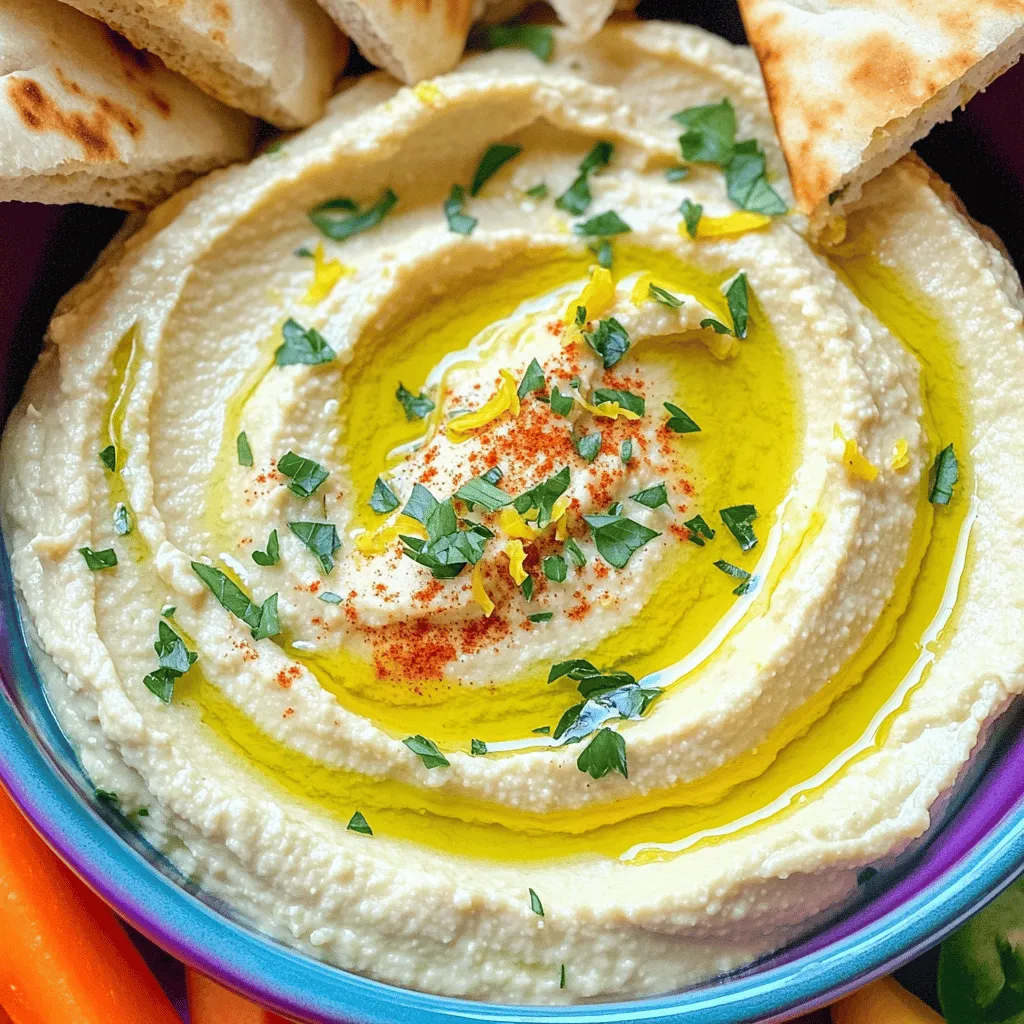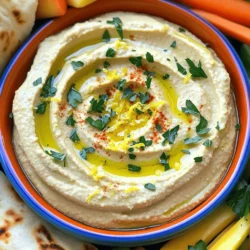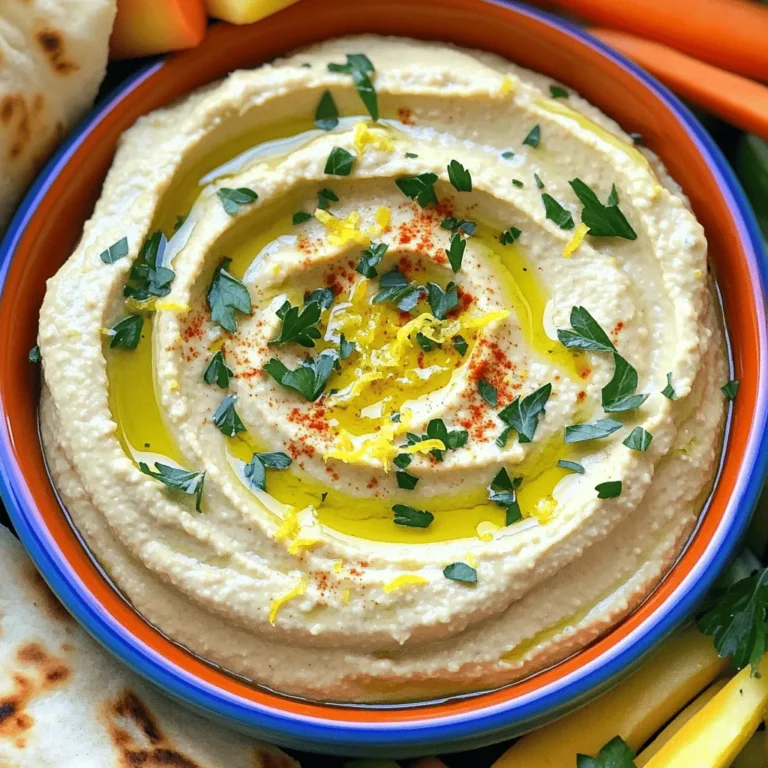If you love bold flavors and easy recipes, you’re in for a treat! My Lemon Garlic Hummus is the perfect dip for any occasion. It’s tasty, healthy, and packed with zest. This blog post guides you through simple steps to make it, from gathering ingredients to achieving that creamy texture. Whether you’re a hummus newbie or a seasoned fan, you’ll find tips and variations that suit your taste. Let’s dive in!
Ingredients
List of Key Ingredients
To make delicious lemon garlic hummus, gather these key ingredients:
– 1 can (15 oz) chickpeas, thoroughly drained and rinsed
– 1/4 cup tahini (sesame seed paste)
– 2 tablespoons extra virgin olive oil
– Juice of 1 medium lemon (about 2 tablespoons fresh lemon juice)
– 2 cloves of garlic, finely minced
– 1/2 teaspoon ground cumin
– 1/2 teaspoon sea salt (adjust to taste)
– 2 to 4 tablespoons water (adjust as needed for a smooth consistency)
– Zest of 1 lemon (to enhance flavor)
– Fresh parsley, finely chopped (for garnish)
– Paprika (for garnish)
These ingredients blend together for a creamy and zesty dip.
Optional Ingredients for Extra Flavor
You can add a few optional ingredients to boost the flavor:
– A pinch of cayenne pepper for heat
– Roasted red peppers for sweetness
– A tablespoon of fresh herbs like dill or cilantro
– A drizzle of lemon-infused olive oil for richness
Feel free to get creative! These extras can take your hummus to new levels.
Substitutions for Common Allergens
If you have allergies or dietary restrictions, here are some easy swaps:
– Use sunflower seed butter instead of tahini for a nut-free option.
– Substitute water with vegetable broth for added flavor.
– If you are avoiding garlic, try using garlic powder instead.
These substitutions keep your hummus tasty while catering to your needs.
Step-by-Step Instructions
Detailed Preparation Process
To make lemon garlic hummus, start with a clean food processor. First, add the rinsed chickpeas, tahini, olive oil, fresh lemon juice, minced garlic, ground cumin, and sea salt. Blend this mixture on high speed. You want it to become smooth and creamy. Pause to scrape down the sides of the bowl with a spatula. This step ensures that every ingredient mixes well.
Guidelines for Using a Food Processor
When using a food processor, always ensure the lid is on tightly. This keeps everything contained and helps blend better. Start blending on low speed, then increase to high. This process avoids splatter and makes blending easier. If the mixture seems too thick, you can add water. Drizzle in two tablespoons while blending. This helps achieve the right texture.
Tips for Achieving the Perfect Consistency
For perfect consistency, keep blending until the hummus is velvety. If you want a thinner texture, add more water one tablespoon at a time. Blend after each addition to check the texture. Once it’s smooth, add lemon zest and blend briefly. This adds a nice burst of flavor. Taste your hummus and adjust seasoning as needed. Add more salt, lemon juice, or garlic if you like. Enjoy the process of tweaking it to fit your taste!
Tips & Tricks
How to Make the Best Lemon Garlic Hummus
To make great lemon garlic hummus, use fresh ingredients. Start with rinsed chickpeas. They give a smooth base. Tahini adds creaminess. Use good olive oil for flavor. Fresh lemon juice brightens the dish. Minced garlic gives it a nice kick. Blend well until creamy and smooth. If too thick, add water slowly.
Enhancing Flavor with Additional Ingredients
You can boost the flavor with extra touches. Try adding roasted red peppers for a sweet taste. A pinch of cayenne pepper adds heat. Fresh herbs like basil or cilantro can make it unique. You can also fold in sun-dried tomatoes for a savory twist. Experiment to find your favorite mix!
Storage and Serving Suggestions
Store leftover hummus in an airtight container. It stays fresh in the fridge for about a week. To serve, drizzle olive oil on top for a nice look. Sprinkle paprika and fresh parsley for color. Hummus pairs well with pita bread or veggie sticks. You can also use it as a spread in sandwiches. Enjoy it with friends or at gatherings!

Variations
Adding Spices for Different Flavors
You can easily change the taste of your lemon garlic hummus. Add spices like smoked paprika for a smoky flavor. Try a pinch of cayenne pepper for some heat. Cumin adds warmth, while fresh herbs bring brightness. Experiment with your favorite spices to find what you love.
Vegan and Gluten-Free Alternatives
This hummus recipe is both vegan and gluten-free. If you want to add creaminess, use avocado instead of tahini. For a nutty taste, almond butter works too. Always check labels to ensure your ingredients are gluten-free. This way, everyone can enjoy it!
Creative Ways to Serve Hummus
Serving hummus can be fun and creative! Use it as a dip for fresh veggies like carrots and bell peppers. Spread it on sandwiches or wraps for added flavor. You can layer it in a bowl with diced tomatoes and cucumbers for a beautiful presentation. Don’t forget to drizzle olive oil on top for a finishing touch.
Storage Info
Best Practices for Storing Hummus
To keep your lemon garlic hummus fresh, store it in an airtight container. I suggest using a glass jar or a plastic container with a tight lid. This helps to keep out air and moisture. Always ensure the hummus is cool before sealing it. If you want to add extra freshness, drizzle a little olive oil on top before sealing.
How Long Does Lemon Garlic Hummus Last?
When stored properly in the fridge, lemon garlic hummus lasts about 4 to 7 days. I recommend checking for any signs of spoilage, like an off smell or color change. If it looks good and smells fresh, it’s still good to eat!
Freezing Hummus for Future Use
You can freeze lemon garlic hummus for later enjoyment. Freeze it in small portions using ice cube trays or small containers. This makes it easy to thaw just what you need. When you’re ready to use it, transfer the hummus to the fridge overnight to thaw. If it looks a bit dry after thawing, just blend in a little water or olive oil to get that creamy texture back.
FAQs
What Can I Serve with Lemon Garlic Hummus?
You can serve lemon garlic hummus with many tasty options. I love pairing it with warm pita bread. Fresh vegetable sticks like carrots, cucumbers, and bell peppers also work great. You can even use it as a spread on sandwiches or wraps. For a fun twist, try it with crackers or breadsticks. Each option adds a new layer of flavor and crunch.
How Do I Thicken Hummus?
To thicken hummus, you can reduce the amount of water you add. Start with just two tablespoons, and blend. If it’s still too thin, add more chickpeas. You can also chill the hummus in the fridge for about 30 minutes. This helps it firm up a bit. Each method gives you a creamy and thick dip.
Is Hummus Healthy?
Yes, hummus is a healthy choice! It’s made from chickpeas, which are high in protein and fiber. The tahini and olive oil provide healthy fats. Plus, garlic offers many health benefits, like boosting your immune system. Enjoy hummus as a snack or meal without guilt.
Can I Make Hummus Without Tahini?
Yes, you can make hummus without tahini. Just skip it and use more olive oil instead. You can also add a bit of yogurt for creaminess. This change still lets you enjoy a tasty dip.
You learned about key ingredients for lemon garlic hummus, plus swaps for allergens. I shared how to make it smooth with a food processor and tips for the best taste. Explore variations to add spices or serve creatively. Storage tips keep your hummus fresh and tasty. Remember, you can adjust the recipe to suit your taste. Enjoy your delicious and healthy lemon garlic hummus, whether you eat it plain or pair it with snacks!


